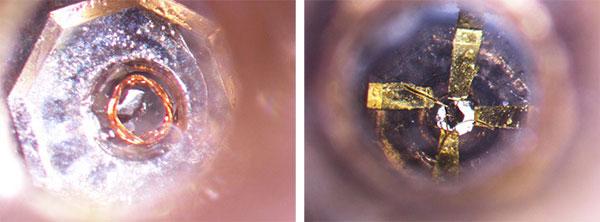Researchers unlock 30-year-old mystery of how a uranium-based material acts as a superconductor

Credit: Yusei Shimizu
Researchers in France and Japan have demonstrated a theoretical type of unconventional superconductivity in a uranium-based material, according to a study published in the journal Physical Review Letters.
By using very high pressure and a magnetic field, the team demonstrated that the uranium-based material UBe13 exhibits ‘triplet superconductivity.’ This is a phenomenon in which electrons form pairs in a parallel spin state. In conventional superconducting materials, electrons of opposite spins pair together, effectively cancelling out each other’s spins.
“Until now, there have been very few clear-cut examples of triplet superconductivity, even though a number of superconductors have been discovered in various metallic systems in the past century,” says Tohoku University materials scientist Yusei Shimizu. “Our pressure experiments at low temperatures have provided strong evidence for spin-triplet superconductivity in UBe13.”
Materials that become superconducting, often at low temperatures, allow electricity to pass through them with virtually no resistance, minimizing energy loss in the process. This phenomenon, discovered initially in some pure metals, has been found in an amazing variety of different systems. Among these, UBe13 was one of the earliest discovered ‘heavy-fermion’ superconductors. The electrons in heavy fermion metallic compounds appear to be 1,000 times more massive than electrons in ordinary metals.
With the new insight, scientists can now explain what happens in the enigmatic uranium material UBe13 at the atomic scale and how it acts as a spin-triplet superconductor in magnetic fields.
A team from Université Grenoble Alpes in France and Tohoku University in Japan measured the superconductivity of UBe13 under varying high pressures at very low temperatures (Figures). They found that the superconducting state in this material is successfully explained by a theoretical model in which electrons form so-called Cooper pairs with parallel spins.
This happens as an ‘unconventional superconducting ground state’ at ambient and high pressures up to six gigapascals. For comparison, diamonds melt using a high-energy laser at a pressure of 1.5 gigapascals. This peculiar superconducting state successfully explains the very puzzling nature of uranium-based triplet superconductors under high magnetic fields.
Currently, superconductors require very low temperatures for peak performance, so they are used primarily in magnetic resonance imaging machines and particle accelerators. Understanding how various materials conduct electricity at the atomic scale could lead to a broader range of applications.
In addition to demonstrating triplet superconductivity, the researchers note that UBe13 could help answer more general questions. For example, the surface excitations of UBe13 might be suitable for physicists to observe theoretical particles called Majorana fermions, an exotic type of composite particle that is its own anti-particle and that could revolutionize quantum computing in the future.
###
Media Contact
Yusei Shimizu
[email protected]
Original Source
https:/
Related Journal Article
http://dx.



